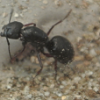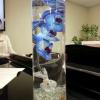I know for a fact that some queens do continue to dig deeper for days. They also backfill their holes. So it may only look like she has excavated only a small amount of dirt, when in reality she has dug a lot more, and just back filled her hole as she goes, all while the nest is closed up. Also the ground does dry out and harden.
Most of the founding chambers I have dug up have been in the desert, and I can tell you for sure, that anymore than three days during the heat of the summer, and you will be lucky to find anything. Now Chromerust, kellakk, and I were just digging some up in the desert last week, and not only did we find a lot of queens, the ground was still very soft and wet. The rain fell a week before we were there. Gregory2455 went to the same location a week later, and even though he found lots of founding chambers, he ended up with hardly anything.
So in the middle of the summer in the desert when it's very hot, you have about three days. During the winter or early spring when it's still quite cool out, I would say you have probably a week before you're wasting your time and gas.



















